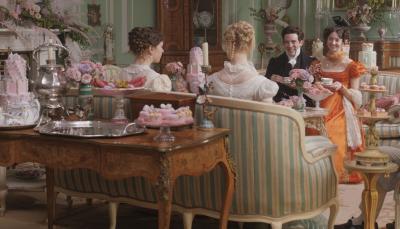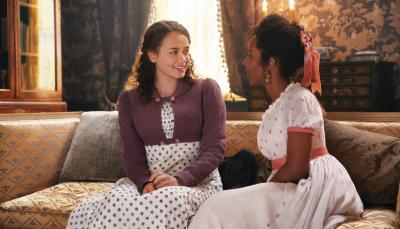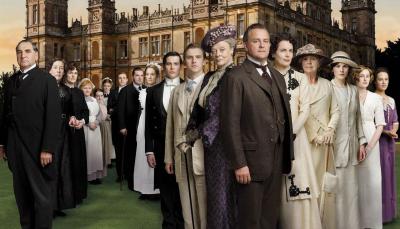'Poldark': Who Was the Real Ned Despard?

When we first meet Ned Despard (played by Vincent Regan) in the final season of Poldark, he's in prison and has written to his old friend Ross, with whom he served in the British Army in the American War of Independence, for help. Ross, always one for the underdog, jumps right in and that makes for big trouble, of the both fictional and historical varieties.
The real Edward Marcus Despard (1751-1803) was born in Ireland to an aristocratic Anglo-Irish family with French Huguenot roots. He was a younger son, and was expected to make his own way in the world, which he did by joining the army at the age of fifteen. He began as an Ensign in the Fifteenth Foot Regiment, was promoted to Lieutenant in 1772. During the American War of Independence, the regiment was stationed at Jamaica to maintain security for British interests, and it was there that he met and befriended the young Horatio Nelson. He also met his future wife Catherine (Kitty), a woman of color whose origins are not clear. One source says that she was the daughter of a freedwoman, another that she was enslaved or a servant. At some point, in between acts of derring-do and adventures with young Lt. Nelson, Despard and Kitty married.
The British were interested in expanding their territory inland on the Mosquito Coast and in 1782 Despard successfully recaptured the British settlement of Black River (Honduras) from the Spanish. It was short lived, as the Peace of Paris returned the colony to Spanish rule, but the coastal areas had a British population that settled there, ignoring sovereignty. Further negotiations carved out a niche of the Bay of Honduras (later Belize) for the British, and Despard, as a reward for his military prowess, was put in charge of resettling the British there and allocating land. But it wasn't just Brits--the population also included a group known as the Shoremen: laborers, brewers, smugglers, freed slaves, and ex-military volunteers. In other words, a mixed race group of the trades and occupations that had grown up around the elites, the Baymen, the all-white, wealthy mahogany dealers.

Despard was given these instructions from the Home Secretary, Lord Sydney:
His Majesty feels an equal concern for all his subjects, & is disposed at all times to listen to their reasonable applications; but in the present instance His Majesty conceives that the Mosquito Settlers who have been obliged to relinquish their possessions ought first to be attended to, especially in the disposal of those lands which may in some degree be looked upon as a consideration for their Settlements upon the Mosquito Shore. Upon this ground His Majesty has commanded me to instruct you that the late inhabitants of the Mosquito Shore who may arrive at the Honduras Settlement are to be accommodated in preference to all other persons whatsoever.
And Despard took this literally. He assigned land by lottery, without taking race or status into consideration, and the Baymen were furious. When they complained to Lord Sydney, he told them that British law made no distinction between white and people of color in matters of land ownership. In other words, he didn't want to get involved and hid behind the law.
When new Home Secretary William Wyndale Grenville was appointed, the Baymen brought up the issue again. But this time they claimed that Despard's policy was threatening the mahogany trade. Grenville suspended Despard, who stood for election as magistrate and won in a landslide election (back atcha!). Despard was summoned to England in 1790 to explain himself. In 1792 he was suspended on half pay and, following further writs from the Baymen, was sent to debtors' prison for two years.
At some point, it seems Despard had had an epiphany. He was married to a woman of color and he had worked side-by-side with mixed race people and the Miskito Indians during the invasion of the Honduras. It was on his return to England that he first read the works of Thomas Paine, the English-born American revolutionary and activist, whose Rights of Man was a seminal text for radicals. He subsequently joined the London Corresponding Society (LCS), an organization dedicated to parliamentary reform for universal suffrage and annual parliaments.
By the time Despard was released from jail, the British government was increasingly nervous about what was happening just over the Channel in France. The great fear was that revolution would come to England and repressive laws were passed, notably the Treasonable Practices Act of 1795 which made criticism of the government illegal.

In 1795 Despard came to the notice of the authorities when he became involved--or not, as he claimed--with a riot in the Charing Cross area of London. When he was stopped and questioned by a constable, he identified himself as Citizen Edward Marcus Despard, using the inflammatory revolutionary title favored by the French. When he was questioned, Despard claimed that since the constable had not read the Riot Act, the official statement used to dispel a crowd, he should not have been arrested. It dawned upon his questioners that Despard was a gentleman, and had he identified himself as such, he would not have been arrested. But it put Despard on the government's radar, and for the next couple of years he, Kitty, and their son John moved frequently to escape surveillance.
As well as joining the LCS, Despard also joined the Society of United Irishmen, an organization that at first agitated for parliamentary reform and then for a united Ireland, going underground and planning freedom from British rule with help from the French. In 1798 when the Great Irish Rebellion took place, Despard was arrested and imprisoned. The government repealed habeus corpus, meaning that Despard could now be held indefinitely without a trial.
And it's now that Kitty swung into action, appalled by the conditions her husband suffered in the Coldbath Fields Prison, a new facility in Clerkenwell, London. She started a letter-writing campaign and lobbied sympathetic members of Parliament. This letter, which she sent to the newspapers, started a three-week debate in Parliament on whether the suspension of habeas corpus should be extended:
Some mention having been made in newspaper reports of the House of Commons, relative to the treatment of Colonel Despard in the new prison, I think it necessary to state, that he was confined near seven months in a dark cell, not seven feet square, without fire, or candle, chair, table, knife, fork, a glazed window, or even a book. I made several applications in person to Mr. Wickham, and by letter to the Duke of Portland, all to no purpose. The 20th of last month, he was removed into a room with fire, but not until his feet were ulcerated by the frost. For the truth of this statement I appeal to the Hon. Mr. Lawless, and John Beever, Esq., who visited him in prison, and at whose intercession he was removed. The jailer will bear witness that he never made any complaint of his treatment, however severe it was. This statement of facts is without the knowledge of the colonel, who has served his majesty thirty years, and all his family are now in the army.
Naturally, some members of Parliament thought she was being used as a mouthpiece by political subversives, and some doubted a woman could even write such a letter. Interestingly, the criticism made no mention that she was a woman of color. Despard himself was more concerned about the issue of imprisonment without trial than the conditions in which he was held.
After three years Despard was released, theoretically an innocent man, when the suspension of habeas corpus lapsed. But in November, 1802, he was arrested in a government raid on a pub called the Oakley Arms in Lambeth, where he and about forty other men, mostly soldiers and artisans, had gathered. The Despard Plot, as it became known, was sensational, impractical stuff--it involved the seizure of the Tower of London, the Bank of England, and armories, and the assassination of King George III.
It was treasonous in intent, and thus equal to treason, according to recent legislation. Despard and six others were imprisoned to stand trial for high treason. Once again, Kitty lobbied on behalf of her husband and the other prisoners, continuing her fight for better prison conditions, and even persuaded Nelson, now a national hero, to testify on his behalf. The legal system at this time relied on character witnesses rather than what we would consider legal evidence. Nelson said:
We went on the Spanish Main together; we slept many nights together in our clothes upon the ground; we have measured the height of the enemies wall together. In all that period of time no man could have shewn more zealous attachment to his Sovereign and his Country, than Colonel Despard did. I formed the highest opinion of him at that time, as a man and an officer, seeing him so willing in the service of his Sovereign. Having lost sight of him for the last twenty years, if I had been asked my opinion of him, I should certainly have said, if he is alive he is certainly one of the brightest ornaments of the British Army.
But naturally, when asked if he had had any recent contact with Despard, Nelson had not seen him for twenty years.
None of the suspects would inform on any others involved in the plot, and they all pleaded "Not Guilty." The sentence for treason was particularly nasty, involving hanging, drawing and quartering--in other words, being publicly tortured to death. The government was rightly nervous about this--popular support for Despard was running high, the newspapers were in a state of frenzy, and public executions were falling out of favor.
So it was decided that death would be carried out by hanging instead, after which the bodies would be beheaded. The executions were to take place at the Horsemonger Lane Goal in Southark, on the flat roof built for that purpose on February 21, 1803. Security was very tight, with police brought in from all over London and a contingent of cavalry. The keeper of the jail was given six rockets to set off if there was any sort of disturbance.
Bizarrely, the death sentence still included one bit of ritual--traditionally traitors were dragged to the scaffold on a hurdle. In this area, and with the vast crowd gathering outside, this wasn't practical, so the authorities created a compromise, dragging Despard a few times around the prison yard.
Two horses were harnessed to a small cart which contained two trusses of clean straw, and whose floor rested directly on the ground. Behind the cart stood the Sheriff of Surrey; behind him a fully-robed priest, and behind the priest the head keeper of the jail, Mr. Ives, solemnly holding a white wand. Behind Ives stood a line of high constables, and behind them a line of duty policemen. Bringing up the rear was the executioner, holding up a drawn sword.
The quartering and dismembering had been waived, but there had never been an execution for high treason without the victim first being drawn through the streets to the scaffold. … Outside the yard, the traditional gallows humour may have been conspicuously absent, but Despard himself was unable to keep a straight face at the display of furtive pomp that confronted him. ‘Ha! ha!’, he laughed, ‘what nonsensical mummery is this?’
The Unfortunate Colonel Despard: And the British Revolution that Never Happened by Mike Jay.
Kitty worked with Despard on his final speech, which was delivered to the mostly silent crowd of 20,000 people. The next time a crowd of that size was to gather in London was for the funeral of Despard's old friend Admiral Nelson.
Fellow Citizens, I come here, as you see, after having served my Country faithfully, honourably and usefully, for thirty years and upwards, to suffer death upon a scaffold for a crime which I protest I am not guilty. I solemnly declare that I am no more guilty of it than any of you who may be now hearing me. But though His Majesty’s Ministers know as well as I do that I am not guilty, yet they avail themselves of a legal pretext to destroy a man, because he has been a friend to truth, to liberty, and to justice.
[a considerable huzzah from the crowd]
because he has been a friend to the poor and to the oppressed. But, Citizens, I hope and trust, notwithstanding my fate, and the fate of those who no doubt will soon follow me, that the principles of freedom, of humanity, and of justice, will finally triumph over falsehood, tyranny and delusion, and every principle inimical to the interests of the human race.
[a warning from the Sheriff ]
I have little more to add, except to wish you all health, happiness and freedom, which I have endeavoured, as far as was in my power, to procure for you, and for mankind in general.
A recently arrived French emigree, Mme. Tussaud, excitedly contacted Despard's friends to request access to his body in order to make a wax death mask, aware of the huge potential business it could bring to her traveling show, Curtius's Grand Cabinet of Curiosities. And Kitty fought one final battle for her husband after his death, to have his body buried in St. Paul's Cathedral, a hereditary right. Once more, thousands attended his burial service, although Despard was laid to rest in an unmarked grave.
As for I'm sorry to say that neither Kitty nor Ned appear to have been abolitionists, which I believe is something scriptwriter Debbie Horsfield created. Consider that Despard's good friend Nelson, who shared the same experiences in Jamaica remained resolutely pro-slavery. William Cobbett, activist and writer, firmly believed that the abolitionist movement was a drain on resources that could be used for parliamentary reform.
And finally, do you think the Despard Plot was real or was Ned set up by the government?




